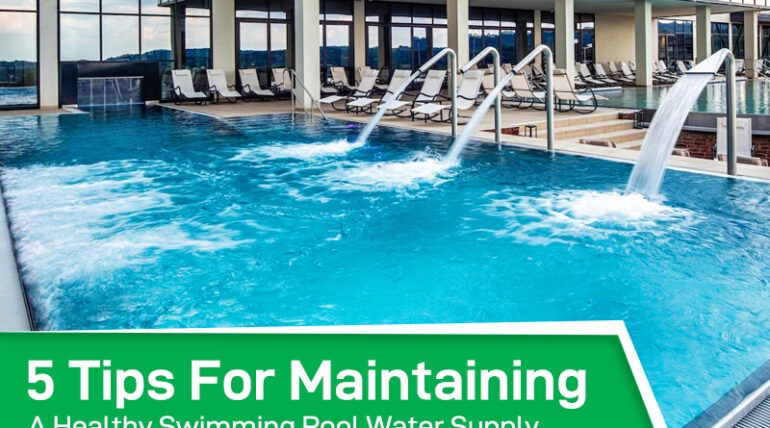
January 16, 2023
Here’s How You Can Assure A Healthy Time In Your Swimming Pool
Having a swimming pool in your backyard is a great way to cool off during hot summer days and entertain guests. However, maintaining a healthy swimming pool water supply can be a daunting task for many homeowners. From balancing pH levels to preventing algae growth, there are many factors to consider when it comes to keeping your pool water clean and safe for swimming. In this blog post, we will discuss 5 tips for maintaining a healthy swimming pool water supply that will help you keep your pool in shape all season long.
Swimming Pool Water Supply
- Get It Cleaned Regularly
Regular cleaning of the swimming pool is highly recommended as it’s obvious to witness a lot of contaminants considering its open nature and that it can accumulate all sorts of unwanted dirt or particles in it. So, cleaning the pool is a must and to remove those contaminants, be it the skin oils, sunscreen, or any hair product, bugs, leaves, or debris you can easily use a net skimmer.
It’s important to follow the right steps when cleaning a swimming pool:
1)First, you need to vacuum all of the leaves, bugs, and debris from the pool floor. 2)Next, use a net skimmer to remove contaminants from the surface of the water.
3)For Deep Cleaning, use a pool brush to scrub the pool walls and floor.
4)You can vacuum again once all of the dirt and large debris has been removed. You will have a beautiful, clean swimming pool to enjoy!
- Maintaining The PH Levels
Maintaining a PH level of 7.2 to 7.8 in your swimming pool is important for a variety of reasons. PH levels affect how acidic or basic the water is, and having low PH levels can be bad for swimmers, your pool, and your wallet. The most immediate effect is felt by swimmers, as the water will sting their eyes, nose, and skin. This can also cause dried-out skin and hair, which can lead to itching. So, it’s important to make sure that the water you use to fill your pool has a pH level of 7.2 to 7.8, which is the ideal range for pool water. If your reading is above or below these levels, you’ll need to fix it as soon as possible.
- Regularly Filtering The Water
The water in your pool is pumped through a filter to remove debris and particles. How long you need to run the filter depends on the size of your swimming pool and the horsepower of your pool pump.
If you are unsure, check with the manufacturer or consult with a pool maintenance professional. Most pool filtration systems are not able to filter all the water in the pool. Chlorination is a common and effective treatment often used alongside filtration to inactivate microbes that may be present in the pool water. The best-maintained pools rely on multiple treatment barriers.
- Keeping The Water Circulating
Poor water circulation can cause your pool to become stagnant, which in turn will make the water murky and create mold on the walls. To prevent this, it is essential to circulate the water as much as possible. If you can’t keep the water flowing all day, aim for at least 10 hours a day. Here is how you can do it.
1) Each morning, place the leaf skimmer in the pool. It is helpful to do this in the deep end so that it can catch debris.
2) Check the skimmer each day. If it is full, empty it. If it is not, add water to the pool.
3) Maintain the correct water level. If the water gets low, add water. If it is high, drain some out.
4) Be sure that the water temperature is between 75 and 90 degrees.
- Chlorination Your Swimming Pool Is A Must
Chlorine is a chemical that disinfects the water by killing bacteria and other organisms that can cause illness, as well as help to remove debris. Chlorine becomes less effective over time, so using a chlorine stabilizer can help to extend the chlorine’s half-life – meaning it will take longer for the chlorine to break down.
In general, the longer your filtration cycle (the amount of time the water spends being filtered), the less chlorine you will need because it will have less time to break down. Similarly, the more chlorine you use, the shorter your required filtration cycle will be.
Remember that there are a range of factors that will affect how much chlorine your pool will need, including your pump and filter system, water temperature, water level, amount of debris, and the number of swimmers in your pool.
With these tips, you can enjoy your pool without worrying about water quality. Remember, a little bit of regular maintenance goes a long way in keeping your pool water healthy and safe for swimming. Happy swimming!
